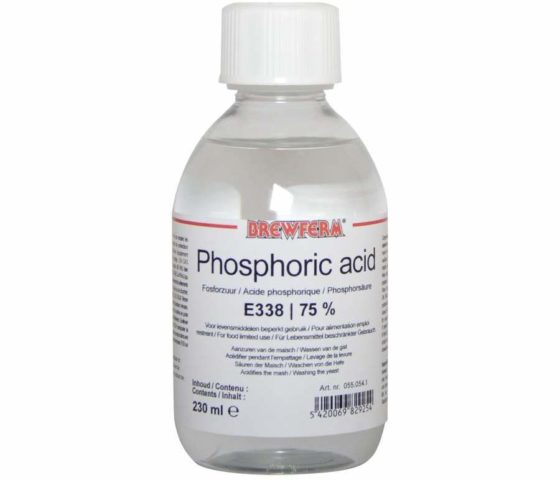Content
Food supplement E338 is an inorganic compound, a weak acid known as orthophosphoric acid. In accordance with the accepted classification, it is included in the group of antioxidants. In industry, the preservative is used as an acidity regulator.
What kind of additive is E338
The antioxidant, which is assigned the E338 index in the international codification system, is a pleasant-tasting mineral substance. In the food industry, it is used as an acidifier.
The additive looks like colorless crystals, which are characterized by a high degree of hygroscopicity. When the temperature rises to 42 ° C, they melt, turning into a viscous transparent liquid. Due to its low melting point and good solubility, the preservative is marketed in the form of a 75-87% aqueous solution. Outwardly, it looks like syrup, it has no smell.
The chemical formula of orthophosphoric acid is H3PO4. The solution, which is made from crystals, is aggressive in its properties.
E338 is packed in bottles or cans made of glass, polyethylene. Also used for transportation are steel containers processed using a special technology. The containers filled with the solution are transferred in wooden boxes or polyethylene drums filled with loose material, with the markings “Corrosive liquid”, “Dangerous” applied to their surface.
What is E338 food supplement made of?
Several methods are used to obtain orthophosphoric acid. The extraction method is considered to be the most cost-effective and least labor-intensive. To obtain Н3РО4, natural phosphates are treated with hydrochloric, sulfuric or nitric acids. As a result of a chemical reaction, pulp remains, which has to be cleaned of impurities and sediments.
A cleaner product can be obtained by using a thermal multistep manufacturing method. Phosphorus is first burned to produce phosphoric anhydride. The substance is absorbed with an acid, condensed and cooled.
The food additive can be obtained by hydrolysis of phosphorus pentachloride. It will also be possible to produce it by reacting phosphorus (V) oxide with water.

What is harmful orthophosphoric acid
The food supplement is considered safe, provided that the established consumption standards are observed. But according to the results of some studies, phosphoric acid has a negative effect on the human body. Under its action, the acid-base balance is disturbed.
It is believed that the use of E338 promotes the leaching of calcium from the body. According to some researchers, bone density decreases under the action of a preservative. Although there is no scientific confirmation of this fact.
Some dentists claim that the dietary supplement negatively affects the condition of the tooth enamel. It acts as a solvent.The sugar contained in beverages containing phosphoric acid is a breeding ground for pathogenic bacteria.
If a food supplement is constantly ingested in large quantities, the risk of developing such negative consequences increases:
- erosion, ulcers in the organs of the digestive system;
- gastritis;
- duodenitis;
- other diseases associated with acid-base imbalance.
Dangerous or not food additive E338
In accordance with the accepted standards, the acidity regulator is assigned a medium hazard class. But the use of a food preservative is allowed in many countries, including Russia, Ukraine, the EU, and the United States.
The Food Code, which is followed by food manufacturers in many countries, allows the use of E338 in 28 standards. The amount allowed varies from 100 mg to 9 g per kg of finished product. The dosage depends on the application.
The body should receive no more than 70 mg per 1 kg of human weight.
Where and why is phosphoric acid added?
The food additive is used by food manufacturers. For their manufacture, a purified substance is taken, which is obtained as a result of thermal treatment of phosphorus. It goes on sale under the brand "A".
E338 is an acidity regulator, it is cheaper than other similar substances. Due to its low cost, the preservative is added to sodas intended for mass production. H3PO4 is found in large quantities in the sweet water of Coca-Cola and its analogues. It is found in Pepsi, Sprite, and others, including diet and energy drinks.

The food additive is used as an acidifier, sorbent, hydrolysis accelerator, antioxidant enhancer in the manufacture of:
- sausages;
- processed cheese;
- confectionery products;
- marmalade;
- syrups.
In the sugar industry, the food additive is used as a bleach.
E338 is used in combination with E927b (urea) in the production of bakery products as a source of phosphorus and a dough quality improver. The substance is added at the stage of preparing the yeast dough.
E338 is also used in other industries. In dentistry, acid is added to teeth whiteners, cleaning mixtures. In animal husbandry, on its basis, drugs are produced for the treatment of urolithiasis. The food additive is popular in industries specializing in the production of household, automotive chemicals, construction and paints and varnishes.
Conclusion
Food supplement E338 is considered safe provided it is received in acceptable quantities. With the abuse of products containing Н3РО4, there is a risk of a decrease in the level of calcium in bones and tooth enamel. Perhaps the appearance of problems with digestion and the development of diseases of the digestive tract, caused by a violation of the acid-base balance. But if the recommended norms for the use of food preservative E338 are observed, there is no danger.

